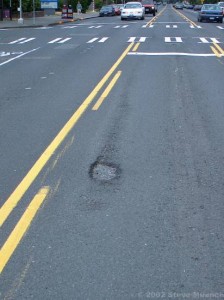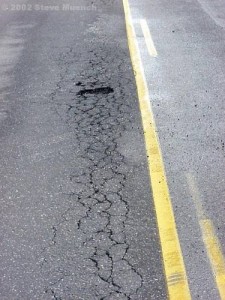Potholes
Small, bowl-shaped depressions in the pavement surface that penetrate all the way through the HMA layer down to the base course. They generally have sharp edges and vertical sides near the top of the hole. Potholes are most likely to occur on roads with thin HMA surfaces (1 to 2 inches) and seldom occur on roads with 4 inch or deeper HMA surfaces (Roberts et al., 1996).

A pothole in the surface course of an urban arterial. This pothole may have come about from fatigue cracking or debonding from the lower layers that started in an excessively raveled area. Left untreated it may eventually spread to the underlying pavement layers.

A pothole beginning to form from an area of excessive fatigue cracking. Notice how just a few chunks of pavement are missing forming the genesis of a pothole. Left untreated, adjacent pavement chunks will be dislodged by traffic making the pothole larger. Additionally, the pothole makes it easier for water to get into the underlying subgrade, further weakening it, and speeding up the deterioration process.
Problem
Roughness (serious vehicular damage can result from driving across potholes at higher speeds), moisture infiltration.
Possible Causes
Generally, potholes are the end result of fatigue cracking. This fatigue cracking can be in the form of top-down cracking or true fatigue failure. Top-down cracking can also come from a debonded overlay. As fatigue cracking becomes severe, the interconnected cracks create small chunks of pavement, which can be dislodged as vehicles drive over them. The remaining hole after the pavement chunk is dislodged is called a pothole.
Repair
In accordance with patching techniques.
Surface Distresses



